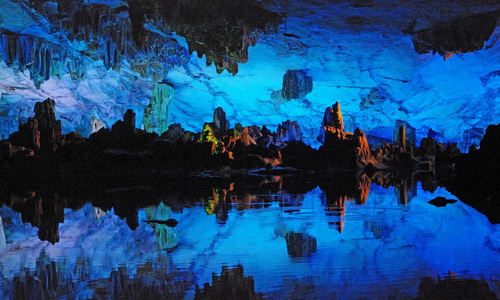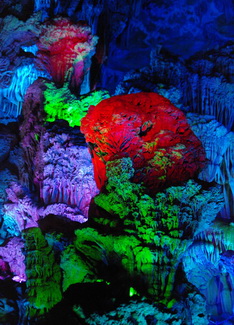Reed Flute Cave
Located about 5 kilometers away from Guilin city center, the Reed Flute Cave is a unique limestone cave formed about 180 million years ago. Praised as the Palace of Natural Arts, the cave is one of the top attractions of Guilin, boasting numerous bizarre stalagmites, stalactites and other rock formations varied in vivid images. Brightly illuminated by multi-colored lights, the cave is more of a dazzling wonderland that could be only discovered in fairy tales.

Inside the cave, over 70 inscriptions written in ink could be still recognized, which could be dated back to the far-reaching Tang Dynasty (618 - 907 AD). By the way, the cave got its name from special reed growing outside that could be made into flutes.
The Reed Flute Cave was formed about 180 million years ago when it was still an underground lake. Attributed to crustal movement, the mountains were elevated and the water level dropped, so the underground lake tuned a cave. Later, underground water sourced from rainfall flowed along the cracks of rock stratum and dissolved the lime carbonate inside. The water carrying carbonate and calcium ion went down deeper to generate crystallizations, which gradually grown into stalactites and stalagmites in different shapes over countless years of water erosion.
About 1,200 year ago, the Reed Flute Cave had been a famous natural attraction, indicated by the ink inscriptions on that wall of the cave. The earliest one could date back to the year of 792 AD in Tang Dynasty.
Travelers in ancient times left their poems and travelogues on this karst wonder. However, the Reed Flute Cave vanished from travelers' sight for about one thousand years after that till it was rediscovered in the early 1940s by a group of Chinese refugees fleeing from the wars. Then the cave was brought into spotlight again by the accidental discovery, and became an extraordinary limestone cave spot home and abroad.
The 240-meter-long Reed Flute Cave is a veritable fairyland of karst wonders, boasting an array of stalactites and stalagmites reaching from floor to ceiling in various fantastic shapes, such as pillars, columns, curtains, birds, umbrellas, plants and animals.
Lit by numerous multi-colored lights placed in the cracks, these glistening rock formations look so surreal and visional that cannot be recreated anywhere else on the globe. Marveling at these vivid masterpieces of natural power, tourists cannot help giving them poetic names, such as Pines in the Snow, Mushroom Hill, Dragon Pagoda, Sky-Scraping Twins, and Virgin Forests and Red Curtain.
- Crystal Palace (Shui Jing Gong)
- Morning Glow on Lion Hill (Shiling Zhaoxia)
- Pines in the Snow (Tasong Aoxue)
- Sky-Scraping Twins (Shuangzhu Qingtian)
The Crystal Palace is the broadest and most gorgeous part of the Reed Flute Cave, about 93 meters in width and 18 meters in height at most.
Stalactites varied in sizes and shapes cascade down from the magical ceiling like brightly illuminated lanterns, which echo with the stalagmites jutting up from the grounds. Veiled by the sparkling lights, the whole cave seems to be a splendid crystal palace made up of exquisite gems, corals and jades.
Another majestic spot is the Morning Glow on Lion Hill. Countless stalagmites and stalactites stretch oppositely to form a flourishing peak forest, and rock formations in lifelike shapes like a pride of lions roaring inside, which are all bathed in the dazzling morning glow created by the neon-lit ceiling.

There are two giant white stalagmites rising abruptly inside the Reed Flute Cave. One is like a strong snowman standing and hiding his hands into the pockets, and the other resembles a tall pine tree with its branches and leaves covered with thick snow, erecting straight without any fear for the chillness.
Among the densely scattered stone peaks tower two columns with similar thickness and heights. They link the ceiling and the ground like two fortified pillars supporting the sky, which are the oldest miracles of the cave formed by water erosion of thousands of years.
1. You are suggested to wear a pair of comfortable and anti-skid shoes as it is wet and slippery in the cave.
2. It is much cooler inside the cave, so you are advised to wear layers in case of getting a cold.
3. Hire a guide could enable you to discover more interesting spots as imagination is the key to appreciating the cave.
4. The Silver Cave in Yangshuo is also worth a visit, but one is enough as they are quite similar.
1. You could take the public city bus No. 3 to Ludiyan (Reed Flute Cave) directly.
2. Taking a taxi from downtown Guilin to Reed Flute Cave might cost CNY20-30.









